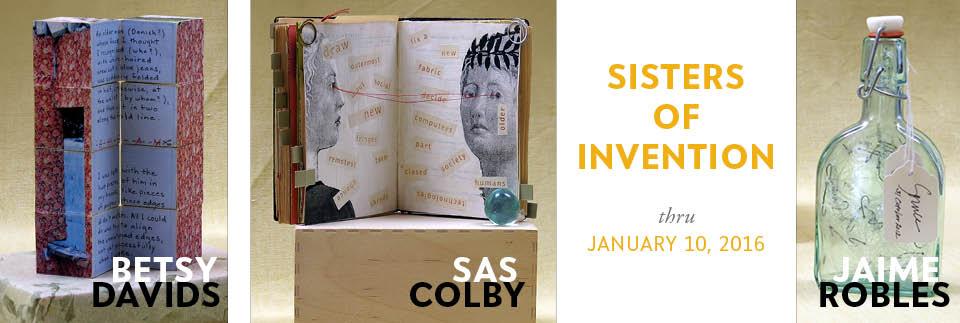Exhibition :: October 23, 2015 thru January 10, 2016
Three Bay Area book artists showed how their art evolved over four decades of spicy page-turning innovation.
Opening Reception :: Friday, October 23, 2015 :: 6:00 PM to 8:00 PM
With dream pumpkins by Betsy Davids, strolling performers (Teresa Attridge, Emmanuel Linden-Broner, Ben Fischer, Don Blair-Settle, Fred Watts) wearing Sas Colby masks and capes from the 1970s, and freshly printed ephemera by Jaime Robles.
Reading Room Pop-up Event :: Sunday, November 15, 2015 :: 6:30 PM to 8:30 PM
Each artist brought books not included in the exhibition for people to touch and read, and tables were set up for viewers to read books that are not otherwise available for handling. The three exhibitors were present for informal chats.A Performance and Video Evening :: Thursday, December 3, 2015 :: 7:00 PM to 9:00 PMBetsy Davids performed an excerpt from A Voice From the Fire, the 1980s Rebis Press & Performing Arts multimedia work on William and Kate Blake. Sas Colby presented a digital slide show with music on the visual and philosophical influences on her work. And Jaime Robles hosted a performance of arias from Vladimir in Butterfly Country and The Spirit of the Moth, sung by bass Richard Mix and soprano Erina Newkirk.
About the Artists
Beginning in the 1970s, Sas Colby, Betsy Davids and Jaime Robles were part of the first wave of innovative book art in the United States. Davids and Robles in the San Francisco Bay Area and Colby on the East Coast. In 1975, Colby move to the Bay Area, one of the centers of avant-garde writing and poetry publications. There were few mentors for women in the traditional print trade at the time, and even fewer following their impulses in the radical combination of visual arts and poetic thought. Davids taught herself letterpress printing by reading J. Ben Lieberman's book Printing as a Hobby. Robles learned by asking questions of the members of the well-established post-San Francisco Renaissance publishing comminuty.
Colby's first books were constructed of stitched textiles, with pockets, zippers and found objects. She was inspired by language and the form more than by the conventional print trade. All three came to making books through text and their love of writing.
Much of Robles' early work was realized at Five Trees Press with Cheryl Miller and Kathy Walkup as part of a collective of women, which included Eileen Callahan and Cameron Bunker, who were interested in producing beautiful books, outside the influence of the male printers of the era. Her work used the codex form, and she provided many of the illustrations for Five Trees Press.
Davids founded Rebis Press, collaboratively producing books with unconventional and unfamiliar structures. Many Rebis books and typographic inventions found a second life in performance with partner James Petrillo. From her earliest moments as a writer and book artist, Davids has explored the dream as primary content.
Since the 1970s, none of these artists has abandoned text or the discipline of artists' books, even while the form of their work has shifted, expanded and changed. Colby's fabric books were followed by Fluxus-style works made of office supplies, collage, and color photocopies. The Brownie camera became both the subject and medium of a series of naive painted books, and photographic books for the wall. In the 1990s Colby created a series of tactile, canvas books with pages of readable paintings. More recent books are bound in the Coptic and address the theme of war. Most of Colby's books are one-of-a-kind, though she has produced a limited edition multiple and a self-published book for the Al-Mutanabbi Street Project.
Davids shifted from the typographic and performative works in the 1980s to the newly-emerging desktop publishing methods for the editions of Dreaming Aloud, the longest of her many dream texts. Thereafter, the type gave way to handwritten texts and printing to the handmade one-of-a-kind bag books and journal books of the 1990s, which emphasized working with the materials of everyday life. The decades of incorporating unexpected materials and unfamiliar structures has led her in the 21st century to wooden flexicubes, sign-painting stencils, woven envelopes, and engraved palm leaves.
During the 1980's Robles began working as a professional book designer in fine arts publishing, working as the manager of The Lapis Press, the letterpress studio of Sam Francis. Simultaneously, she produced one-of-a-kind books that included extensive drawing and printmaking. In the 1990s she worked extensively as a designer in trade publishing and devoted her artistic impulses to poetry and poetics - writing librettos for composers. Recently, she has returned to combining visuals that are performative in a broader sense, doing a series of environmental and site-based installations. She publishes her writing in journals and with Shearsman Books in the UK.
Exhibition Catalog
A fully illustrated catalog of this exhibition may be purchased from San Francisco Center for the Book.
Sponsors
Grants for the Arts | San Francisco Hotel Tax Fund
The Kahle Austin Foundation
The Kahle Austin Fund through the San Francisco Foundation
Zellerbach Family Foundation
Anonymous

